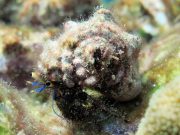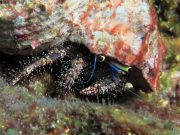Diving with Hermit Crabs
Lanta Marine Life | Diogenidae
Hermit crabs are common at all of Koh Lanta's dive sites, but you need to know wheat you're looking for in order to spot them during a dive.
The family Diogenidae comprises the 'left-handed hermit crabs' as the left claw is enlarged, rather than the right claw which is the case for the majority of hermit crabs.
There are 429 species of left-handed hermit crabs, however these are not actually 'true crabs' as they do not have an external shell on their soft abdomen.
The lack of shell on the abdomen leaves these crabs easily open to predators, and so to protect themselves, they live in abandoned snail shells.
Each crab has a pair of claws and 2 pair of walking legs. The last 2 pairs of legs are small and modified and along with appendages at the end of the abdomen, are used to clamp onto the internal whorls of the shell.
They can retract their entire body can be into the shell to protect themselves when needed. Eventually they outgrow their shell, and will search for a new one.
3 species found on this page:
Hairy Red Hermit Crab
(Dardanus lagopodes)
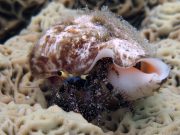
Dardanus lagopodes @ Koh Haa
The Hairy Red Hermit Crab claws and legs are ringed alternately with varying brownish to dark red bands and lighter/whitish bands. The legs are covered with dark red bristles with white tips. The walking legs have one or two much darker bands which are almost hairless.
The eye stalks are pale yellow with dark brown or black eyes at the tips. Both short and long antennas are variably coloured from blue to yellow.
The Hairy Red Hermit Crab is also known as the Dark Knee Hermit Crab and grows to 4 am - 8 cm in length. The head is hairy, however the body is hairless and covered in many white spots.
White-spotted Hermit Crab
(Dardanus megistos)
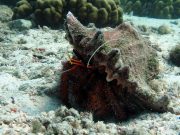
Dardanus megistos @ Koh Haa
The White-spotted Hermit Crab is a left-handed hermit crab which means that the left claw is much larger than the right claw.
This crab has a red to dark orange carapace, claws and legs, covered with many dark-ringed white spots. The claws have spines and are covered in stiff bristles.
The eye stalks are dark red to maroon, with dark grey to greenish brown eyes. This species has long, white antennae, and grows to 15 cm.
Less commonly seen during the day, more usually active at night.
Gaimard's Hermit Crab
(Calcinus gaimardii)
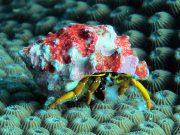
Calcinus gaimardii @ Koh Haa
Gaimard's Hermit Crab is a left-handed hermit crab and is easily identified by the eye stalks, which are yellowish-orange to dark orange-brown, but always with a pale-blue tip with a dark-blue ring almost right at the end of each eye stalk.
The antennae are also orange and the claws and legs vary from orange to red to brown.
Gaimard's Hermit Crab grown to 2 cm in diameter and 4 - 5 cm in length.
Diving with Hermit Crabs around Koh Lanta
Scuba Diving & Snorkel Trips
If you'd love a chance to spot Hermit Crabs on one of our daily high season diving trips from Koh Lanta then send us an email to info@diveandrelax.com.
Join our high season speedboat dive trips to some of Thailand's best dive sites and enjoy small groups, short journey times, with a focus on great personal service, safety and fun.
Not yet a certified diver? Learn to Scuba Dive on Koh Lanta with the 3 day SSI Open Water Diver course.
Book online to save 10% on dive trips and scuba courses on Koh Lanta.
Find Out More
Indo-Pacific Marine Life Guides
- Allen, G., Steene, R., Humann, P., DeLoach, N. (2003) Reef Fish Identification, Tropical Pacific. Jacksonville, FL., USA: New World Publications, Inc., ISBN 1-878348-36-1.
- Humann, P., DeLoach, N., (2010) Reef Creature Identification, Tropical Pacific. Jacksonville, FL., USA: New World Publications Inc., ISBN 978-1-878348-44-9
- Debelius, H. (2013) Indian Ocean Reef Guide. Frankfurt, Germany: IKAN - Unterwasserarchiv, ISBN 978-3-939767-52-7.
- Debelius, H. (2004) Nudibranchs and Sea Snails, Indo-Pacific Field Guide. Frankfurt, Germany: IKAN - Unterwasserarchiv, ISBN 3-925919-51-1
- Erhardt, H., Knop, D. (2015) Corals Indo-Pacific Field Guide. Frankfurt, Germany: IKAN - Unterwasserarchiv, ISBN 3-925919-69-4.
- Veron J.E.N., Stafford-Smith M.G., Turak E. and DeVantier L.M. (2016). Corals of the World

